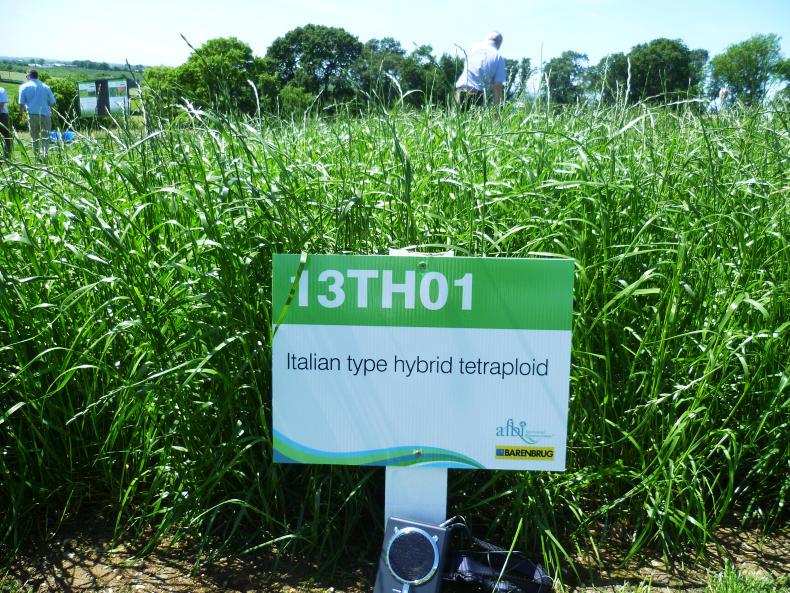Farmers keen to grow more grass and maximise production on their farms, could look to grow alternative grasses such as Italian and hybrid ryegrasses.
Highlighting the potential at the ‘‘More from Grass’’ event held at AFBI Loughgall last week, James Ingles from grass-seed supplier, Barenbrug, suggested that Italian ryegrass can deliver a 30% yield improvement over perennial counterparts.
Newer Italian varieties have improved digestibility, and are more productive, with the ability to keep growing at the shoulders of the year under lower temperatures.
The downside is that the crop is biannual (lasts two years), must be cut regularly or will run to stem, and has a high requirement for nitrogen if it is to yield to its potential.
A less risky option are hybrid ryegrasses, which are obtained by crossing perennial and Italian ryegrasses. They will last around five years if properly managed, said Ingles, will give excellent spring production and are suitable for intensive silage regimes.
Plots of hybrid ryegrass at Loughgall were ready for a third cut last week (see picture).
However, hybrid grasses are difficult to manage in a grazing situation. “You would really need to be on top of your game. They lend themselves to cutting rather than grazing,” insisted Ingles.
Heavier soils
For those working on heavier soils, there are other alternatives to perennial ryegrass worth exploring. Timothy is palatable for livestock, winter hardy, and will perform in wet soils, making them less prone to poaching damage. It should also survive a flooding event (unlike many new perennial ryegrasses) and should be included in seed mixtures in higher rainfall areas.
“We are also finding that Tall Fescue is more and more useful. Once established it is incredibly persistent. Its root system can go down six feet, meaning it will tolerate very dry conditions. It will also survive on flood plains,” confirmed Mhairi Dawson from Barenbrug.
Low input
In a low-input system, she maintained that Barmix marketed by Barenbrug will give a 20% yield benefit over perennial ryegrass mixes. A 14kg bag of Barmix contains 7kg of perennial ryegrass (Dundrum and Glenariff) along with 4kg of Tall Fescue, 1kg of Cocksfoot, 1kg of Timothy and 1kg of white clover.
“It will do well in a low nitrogen situation or where clover is the main nitrogen source,” said Dawson.
However, if the sward is not well managed in the spring, Cocksfoot (which is also drought tolerant) can tend to take over by the third year, acknowledged Dawson.
For farmers with some land prone to flooding, Barmix has a potential role, but perhaps with the Cocksfoot removed, to make management easier in the spring.
In 2016, AFBI was confirmed as a member of the new UK-wide Centre of Innovation and Excellence in Livestock (CIEL). Some of the resultant funding is being used to create a precision grassland platform at AFBI Hillsborough, which will test and use new technologies to manage dairy cows in a grazing environment.
Speaking at the More from Grass event at Loughgall last week, Dr Debbie McConnell from AFBI outlined how one of the technologies being investigated was the use of a drone, fitted with a digital camera, to measure grass yield and quality.
The technology works by measuring light reflectance from the sward.
“It could potentially fly a grazing block in 20 to 30 minutes, that would otherwise take two to three hours to walk,” said McConnell.
Initial work suggests that the drone is reasonably good at measuring swards of up to 3,500kg dry matter per hectare, but might be less accurate in heavier swards for silage.
Other issues to be overcome include variability caused by environmental factors such as shadows from cloud, or differences in light reflectance due to grass species. “The potential is there, but there are questions to be overcome,” said McConnell.
First cut is critical to life of the reseed
There is little point going to the cost of reseeding if subsequent management is not of a high standard.
The pH status of the soil must be correct (at least 6), and the sward will quickly deteriorate unless nutrient requirements (N, P and K) are met.
Also to be avoided are heavy first-cut yields, warned AFBI grass breeding specialist, Dr David Johnston. Where first cut is delayed and grass goes to seed, nutrients move from the leaf to the stem, the plants get weak and no light gets in at the bottom.
“It is very sore on reseeded grass. We then tend to finish off the sward with a thick coat of black slurry,” Dr Johnston said.






 This is a subscriber-only article
This is a subscriber-only article












SHARING OPTIONS: